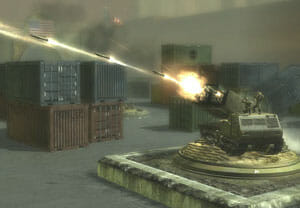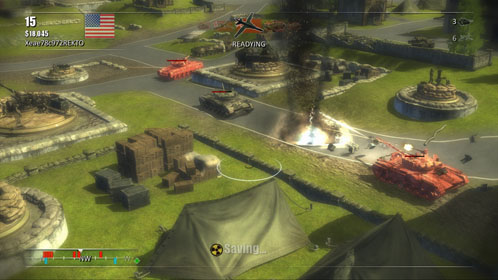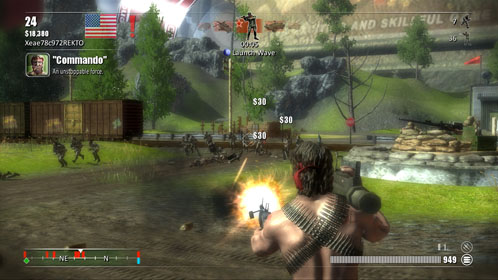
As gimmick records go, the 2000 album Gizmodgery by Matt Mahaffey’s band Self is one of the best. Every song was recorded exclusively with toy instruments, such as you’d find on the shelves of your local Toys“R”Us. You’d think that conceit would be a recipe for disaster for any rock musician worth his salt, a one-way ticket to Weird Al territory. But Mahaffey’s knack for catchy hooks, funky harmonies, and effects wizardry make Gizmodgery stand on its own as a rock album, not merely as a novelty. It transcends its gimmick.
At first glance, Signal Studios’ recent Xbox Live Arcade release Toy Soldiers: Cold War might look similarly gimmicky. Like its WWI-themed predecessor, Cold War is a twist on the tower defense genre in which plastic armies face off for control of a toy box battlefield. This time around, the backdrop is a flashy, tongue-in-cheek recreation of the long-running U.S.-Soviet conflict—as filtered through the stereotypes of an ‘80s action movie. The tone is pitch-perfect: from the red-white-and-blue fighter jet exhaust to the synth-heavy soundtrack, Cold War feels like a G.I. Joe playset come to life. The game’s riffs on Reagan-era staples like Rambo and Top Gun are immediately endearing. The world outside the battlefield—a young boy’s bedroom—is now littered with floppy disks, boomboxes, and other ‘80s paraphernalia. It’s easy to once again slip into the mindset of a kid playing with action figures.
Still, as I booted up the game, I couldn’t help but wonder if Cold War would simply be the original Toy Soldiers with a fresh coat of paint. Would exchanging biplanes for F-14s really make that much of a difference? The mechanics of the first game were great fun: build different types of turrets to defend your toy box base against waves of enemies; take direct control of a turret at any time to concentrate fire; hop into a vehicle to motor into the thick of the fray. I knew Cold War would follow the same formula that had made its predecessor a sleeper hit last year. But the bigger question remained: would the game’s conceit hold up? Or would the new paint job just expose the fact that you’re still playing with toys?
As it turns out, playing with toys is still great fun.

Cold War is the latest entry in a welcome trend: sequels that improve on their predecessors while preserving the core formula that made the originals successful. The remarkable innovation of the first game—allowing you to jump right into the action by taking control of units, thus breaking the reactive mold of most tower defense games—is unchanged. And the unique tension that mechanic fosters, the challenge of balancing macro-level management of your defenses with micro-level control of individual units, still makes for exciting play. The AI is competent enough in managing your turrets, but nothing beats hopping into the gunner’s seat to mow down enemies yourself.
While the essential Toy Soldiers recipe is intact, Cold War adds a number of flourishes. The standard turret types are still present: machine gun, anti-tank, anti-air, artillery. But there’s even more incentive to jump into them yourself, as racking up a streak of kills fills a turbo-charge meter. Maxing out the meter awards you a powerful bonus—a nuclear strike, a stint in the gunner’s seat of an AC-130 gunship, an artillery barrage. Then there’s everyone’s favorite, the Commando. Emerging from a blister pack, this invincible action figure spouts Rambo-esque one-liners (“This one’s for Jimmy!”) as you use him to devastate enemy forces. Fair warning: you may find yourself walking around your house talking like Stallone on Novocaine after a few rounds with this mulleted hero.
Vehicular combat also plays a larger role in Cold War. Vehicles depend on battery power, which means you have limited time to use them; find a battery on the battlefield to extend your ride a little longer. Since piloting an attack chopper or commanding a heavy tank can tip the scales in your favor, Cold War gives the player plenty of opportunities to take the helm, but it balances that power nicely with the cooldown mechanic. This adds another strategic layer to battles, as you’ve not only got to plan where to locate which type of turret, but also when to control each type of vehicle.

For me, the most remarkable feature of the Toy Soldiers games is how they make me enjoy things I usually don’t. Tower defense games can get stale quickly, but Cold War gives the player a range of abilities and objectives to keep him engaged. Accomplishing specific goals in each level earn you Decorations, which, while not useful beyond the inevitable Achievement, give you a reason to experiment with different weapons, vehicles, and strategies. Obsessive stat tracking, which I usually find tiresome, is actually a plus in Cold War; you are told in real time and on loading screens how many bullets you’ve fired, tanks you’ve destroyed, etc. compared to your friends. I almost never get sucked into Leaderboard chases, but with Cold War, I couldn’t help the urge to shoot down one more fighter jet than my pals.
Cold War also features a Survival mode with three specially-designed maps as well as cooperative and competitive multiplayer modes, both of which leverage the strengths of the core game. There are also several included minigames, which, because of the toy box conceit, have a charm others don’t. In both the campaign and other modes, Signal Studios managed to hit the right arcade and strategy notes to appeal to a range of players.
While Cold War’s personality does go a long way, it can’t entirely compensate for the game’s few flaws. As in the original, the camera can be problematic. The ground-level camera often angles too sharply near the dirt, obscuring the view. While the bird’s-eye vantage point does give you a good look at your half of the battlefield, it removes all the excitement of combat. Camera issues also contribute to an odd perception of space, particularly vertically. The thrill of piloting an F-14 fighter is somewhat lessened by a lack of room to maneuver. Still, these are fairly minor problems in an otherwise highly polished title.
As a child of the ‘80s, I get a kick out of Cold War’s lighthearted take on the period. But like Self’s Gizmodgery, Toy Soldiers: Cold War transcends its gimmick with its solid fundamentals. Kudos to Signal Studios for steering clear of Weird Al territory.
Toy Soldiers: Cold War was developed by Signal Studios and published by Microsoft Studios. It is available for download over Xbox LIVEArcade for 1200 Microsoft Points (roughly $15 dollars US).
J.P. Grant is a Boston-based freelance writer whose work has appeared in Kill Screen, Gamers With Jobs, and other outlets. He blogs about games at http://infinitelag.blogspot.com and can be found on Twitter at @johnpetergrant.